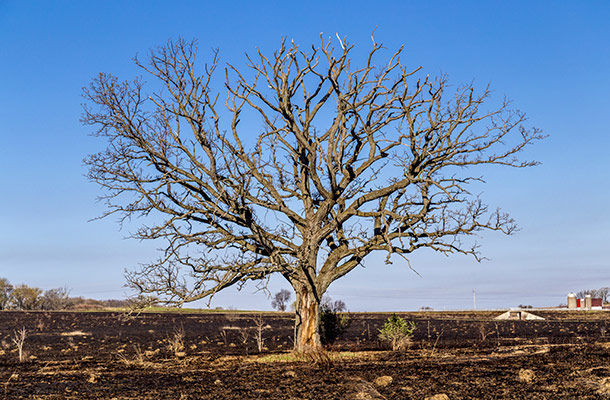
It’s no secret that many parts of the world are experiencing drought conditions, and some to a disastrous extent. So what will happen to your trees during a drought? How will they make it through without drying out? Thankfully Mother Nature built in an emergency system right into the tree to help it survive stress during dryer times.
The First Signs of Drought
Though the very first signs of drought might be very noticeable in the form of no rain. But the first signs in your trees will look a little less drastic at first. Trees are complicated organisms in that they respond directly to the environment around them. When trees first start to notice that they aren’t getting enough water they will institute some smaller measures to help prevent serious damage. And to make things more confusing, each species of tree responds differently to drier conditions.
Drought Affects the Leaves and Roots
Firstly the trees will stop growing new leaves. The leaves that are on the tree may change colors, or even wilt and turn brown before falling off. Any new branches that had started would stop growing, or grow very short. If that measure doesn’t work they will allow some of their feeder roots in the root system to die back in an effort to conserve nutrients. In some cases of serious drought the root systems can die back so drastically that it can kill the tree. However, it would take a long while for the tree to respond in such a drastic manner.
Not all trees die in the first year of a drought though. Pines are pretty resilient in drier conditions. Pines will usually keep their needles for at least two years before showing the signs of stress on the tree. You would first notice that the second year needles would start to turn brown. Though the tree will probably be fine, that will be the time to watch out for insects. Pine bark beetles instinctively know when a pine is stressed and will move in to take over.
Tree Die back
If the drought persists and the situation gets very bad, you may start to notice die back in the crown of the tree. When the canopy of a tree starts to thin out it puts the tree under enormous stress. This will be the time when insects will take advantage of the situation and attack the tree. It will be very important for you to keep an eye on the tree and thwart any infestation as soon as it begins. If you can prevent an infestation the tree may live through the drought conditions.
What You Can Do
When you are aware that you are in a drought situation, it is important for you to take measures to help preserve your trees.
- The first thing you will want to do is to spread a nice three-inch layer of mulch on the ground to cover the soil under the tree. You want enough under there to keep the ground as moist as possible when it is watered.
- Discontinue the use of harsh fertilizers during a drought. The amount of nitrogen and salts in them can cause serious damage to trees if they are not getting enough water regularly.
- Also, be sure to prune all of the dead branches and old growth out of the tree to discourage pests from setting up homes.
- Next, you need to find out from your municipality how much water you are permitted for your trees. It is suggested that you follow the guidelines for each individual tree species when watering. When you water the trees you want to make sure that it is as deep of a water as you can apply, you want to soak the ground with about 1 to 4 inches of water. Small surface watering will not be of much help.
Some other things to bear in mind that can help you in your fight against the drought. Though clay type soils retain water much better during drought conditions, trees growing in clay type soil don’t grow as deep root systems and may be more impacted by the drought. Be sure to keep them watered to prevent them dying. By learning how to handle your trees in drought conditions, they stand a much better chance of making it through the dry spell than if they are left to go it alone.
Follow this link for more tips and tree articles.